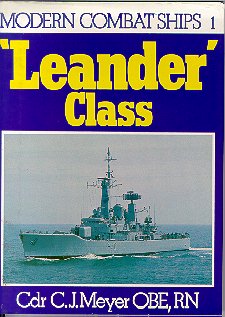|
|
| Tell me when this page is updated |
|
|
| Tell me when this page is updated |
|
|
'Leander Class' Modern Combat Ships 1 by Commander C.J. Meyer, OBE, RN, Ian Allan Ltd., Shepperton, Surrey, England, 1984 Review by Felix Bustelo
 The "Leander" class of general-purpose frigates were an improvement of the Type 12 "Whitby" and "Rothesay" class of anti-submarine ships. The first "Leanders" were commissioned in the early 1960's and by 1973, they were the largest class of major warships in the Royal Navy. In total 26 ships were built for Royal Navy service and the design proved so successful that 4 ship were built for New Zealand and Chile. An additional 14 ships based on this class were constructed by the Australian, Indian and Dutch navies. While most of these ships were eventually scrapped, some are still in service after being sold by the Royal Navy. This book is the first volume in a series titled Modern Combat Ships. The 112 page hardcover book is well written and profusely illustrated with 159 photos, of which only the cover shot is in color. The book describes the need for a general-purpose frigate and reviews the evolution of this type of ship in the post World War II Royal Navy. The author covers the design and construction of the "Leanders" and describes the various weapons and sensor systems deployed as well as the steam propulsion plant. Chapters are devoted to the foreign built and British export "Leanders" as well as their service from the 1960's through the deployment of HMS Andromeda, Argonaut, Minerva, and Penelope in the Falkland Islands War. The modernization and refits of this class are discussed to some extent. As these ships got older and needs changed to meet new demands and threats from more advanced weaponry, most of these ships had their twin 4.5in Mk. 6 turrets replaced with either Ikara, Exocet or Seawolf missile systems. Appendices cover such topics as name origins and histories, specifications, modernization plans and a chronology for the ships in this class. For the modeler, "Leanders" are an excellent subject with all of the different variations leading to numerous conversion projects. The book's 159 photos offer ample visual references. However, and perhaps it is I, I am still somewhat confused as what modernization and modifications were made to some of the ships in this class. For example, some photos show "Leanders" with the towed Variable Depth Sonar (VDS) rig and the associated well, while others don't have this feature. Some ships had the VDS removed and the well plated over. As a modeler, I think that the author could have done a better job of documenting the changes made to each ship during their respective careers, similar to the appendices found in the Raven and Roberts books on British World War II battleships and cruisers. Despite this shortcoming, this book is a very good reference on this important class of ships and the visual references are indeed worth purchasing the book for.
Return to Book Reviews |